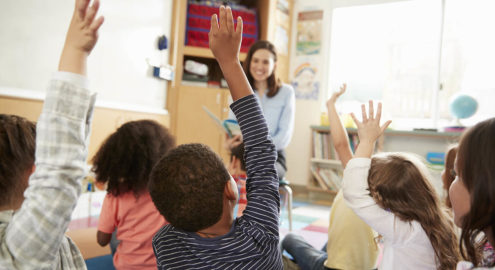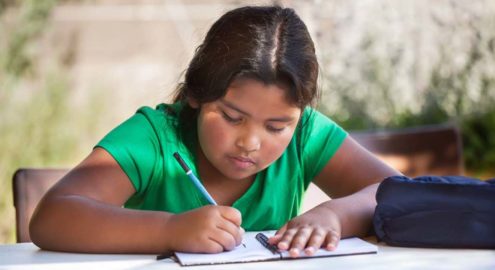What Is It?
Mindfulness is both a practice and a way of relating to life.
Researchers define it as the awareness that arises when we intentionally pay attention in a kind, open, and discerning way. When we are mindful, we focus on the present moment non-judgmentally.
A teacher practicing mindfulness in the middle of a school day might take a break between classes to close her eyes and focus on the sounds she can hear outside of her classroom (e.g., children playing at recess, singing in the halls, etc.). If her mind wanders away from those sounds to the past (“Oh, I can’t believe my colleague said that to me?!”) or the future (“My lesson plan isn’t ready. I’m going to be up for hours preparing for class tomorrow!”), she observes the thought or feeling with quiet curiosity as it moves through her mind, and then she gently redirects her focus back to the present moment and the immediate sounds she hears.
Mindfulness, as a practice, features two different types of attention: focused attention and open awareness.
When we focus our attention, we concentrate on a specific target.
Before a staff meeting, a principal anchors her attention on the sound of a chime or the feel of the air entering her nostrils as she breathes.
During open awareness (also called “open monitoring”), we simply notice things—like thoughts, feelings, or sounds—as they come and go.
To calm himself after a difficult interaction with a parent, a teacher practices open awareness by observing a body sensation, such as a chill or a sneeze passing through him, and then by noticing a loud car drive by his classroom.
The practice of mindfulness also helps us to become more mindful in our daily lives by cultivating these three key life skills.
Equanimity is the ability to allow sensory experiences to come and go without suppressing or avoiding them. Equanimity also helps us not to over-identify with an event, thought, or feeling (or make it too personal).
A teacher whose student has just insulted him in the middle of class says to himself, ”Okay, I’m really angry right now. I’m feeling the anger move through my body; I’m not going to fight it, but I’m not going to be swept up in my it either.”
Concentration is the ability to focus on what we consider to be relevant at a given time.
An educator who regularly practices mindfulness finds herself more capable of focusing on one student’s question in a given moment —rather than being distracted by all the administrative tasks piling up on her desk, the phone ringing, and the 25 other things competing for her attention. (One thing at a time!)
Sensory clarity is the ability to keep track of what we’re actually experiencing in the moment.
A school psychologist with a regular practice of mindfulness whose job involves counseling anxious teens has become more aware of the bodily sensations she feels when she experiences challenging vicarious emotions such as anger or fear—like the pace of her heartbeat as it intensifies and then dissipates and eventually returns normal.
Why Is It Important?
With more educators viewing mindfulness as a valuable habit of mind, it holds a lot of potential for improving the emotional lives of teachers—and ultimately shifting classroom climate and school culture. A growing body of research suggests that teachers are experiencing positive, measurable outcomes from practicing mindfulness. Here are some examples:
Mindfulness helps us focus.
- Teachers who practice mindfulness may experience an increase in awareness, focused attention, and working memory capacity.
Mindfulness makes us feel better.
- Educators participating in mindfulness interventions report greater well-being and self-compassion as well as an increase in positive emotions.
Mindfulness helps us become more adaptable.
- Studies demonstrate that teachers who practice mindfulness experience an increase in both emotion regulation and resilience.
Mindfulness is good for our mental health.
- Several mindfulness studies with educators indicate that a few weeks of practice may result in a reported decrease in burnout, stress, anxiety, and depression.
Mindfulness improves our physical health.
- Educators who have participated in mindfulness studies also report benefits to their physical health, including better sleep quality and lower blood pressure.
Mindfulness enhances our relationships with students.
- Regular mindfulness practice may ultimately influence the way teachers view and relate to their students. After nine weeks of mindfulness practice, some teachers report that they are more likely to positively evaluate challenging students and that they have a greater tendency to forgive them.
Mindfulness can make us better teachers.
- With all of these positive outcomes in play, mindfulness practice may also help teachers to navigate the sense of “time pressure” they feel in their classrooms while enhancing their sense of efficacy in the classroom—which can positively influence teaching effectiveness.
Practice Collections
Practices

Mindful Self-Compassion for Adults

Imagining Flourishing and Kindness: A Mindfulness Practice for Adults

Mindful Reflection Process for Developing Culturally Responsive Practices

Common Beliefs Survey: Teaching Racially and Ethnically Diverse Students

Quotes and Sayings: A Contemplative Practice

Positivity Journals for Teachers

Mindfully Creating Positive Relationships with Students

Three-Minute De-Stressor for Teachers

Mindful Poetry Moments

Mindful Music Moments

Reading Ourselves Whole: A Contemplative Choral Reading Method

I See You. Everyone Matters.

Dimensions of Difference and Similarity Reflection

Contemplative Writing

Loving-Kindness for Adults

Brief Body Scan

Body Scan for Sleep

Self-Compassion Break for Adults

Do you want to dive deeper into the science behind our GGIE practices? Enroll in one of our online courses for educators!



